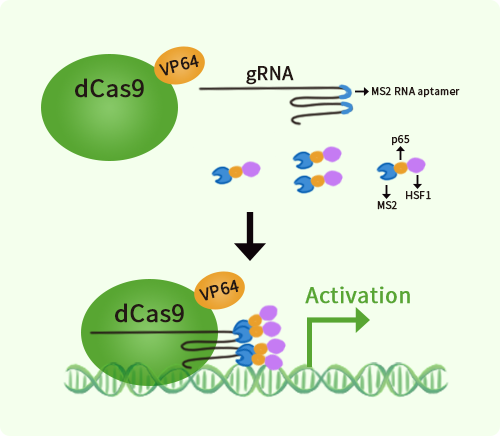Human Alkaline Phosphatase (ALPL) activation kit by CRISPRa
CAT#: GA100173
ALPL CRISPRa kit - CRISPR gene activation of human alkaline phosphatase, biomineralization associated
Find the corresponding CRISPRi Inhibitor Kit
USD 1,290.00
2 Weeks*
Specifications
| Product Data | |
| Format | 3gRNAs, 1 scramble ctrl and 1 enhancer vector |
| Symbol | ALPL |
| Locus ID | 249 |
| Kit Components | GA100173G1, Alkaline Phosphatase gRNA vector 1 in pCas-Guide-GFP-CRISPRa GA100173G2, Alkaline Phosphatase gRNA vector 2 in pCas-Guide-GFP-CRISPRa GA100173G3, Alkaline Phosphatase gRNA vector 3 in pCas-Guide-GFP-CRISPRa 1 CRISPRa-Enhancer vector, SKU GE100056 1 CRISPRa scramble vector, SKU GE100077 |
| Disclaimer | The kit is designed based on the best knowledge of CRISPa SAM technology. The efficiency of the activation can be affected by many factors, including nucleosome occupancy status, chromatin structure and the gene expression level of the target, etc. |
| Reference Data | |
| RefSeq | NM_000478, NM_001127501, NM_001177520, NM_001369805, NM_001369803, NM_001369804 |
| Synonyms | AP-TNAP; APTNAP; HOPS; TNAP; TNSALP |
| Summary | 'This gene encodes a member of the alkaline phosphatase family of proteins. There are at least four distinct but related alkaline phosphatases: intestinal, placental, placental-like, and liver/bone/kidney (tissue non-specific). The first three are located together on chromosome 2, while the tissue non-specific form is located on chromosome 1. The product of this gene is a membrane bound glycosylated enzyme that is not expressed in any particular tissue and is, therefore, referred to as the tissue-nonspecific form of the enzyme. Alternative splicing results in multiple transcript variants, at least one of which encodes a preproprotein that is proteolytically processed to generate the mature enzyme. This enzyme may play a role in bone mineralization. Mutations in this gene have been linked to hypophosphatasia, a disorder that is characterized by hypercalcemia and skeletal defects. [provided by RefSeq, Oct 2015]' |
Documents
| Product Manuals |
| FAQs |
Resources
Other Versions
| SKU | Description | Size | Price |
|---|---|---|---|
| KN405692 | ALPL - KN2.0, Human gene knockout kit via CRISPR, non-homology mediated. |
USD 1,290.00 |
{0} Product Review(s)
Be the first one to submit a review






























































































































































































































































 Germany
Germany
 Japan
Japan
 United Kingdom
United Kingdom
 China
China
